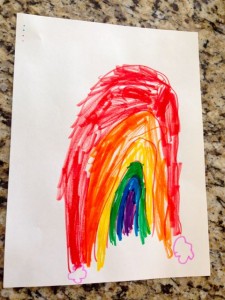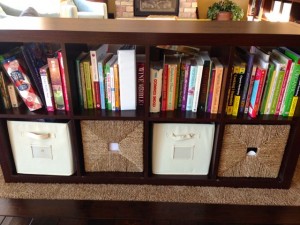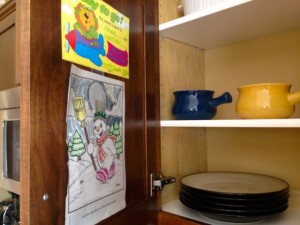Let’s face it. When it comes to the question of “to keep or not to keep”, the answer isn’t always simple when it comes to the special things in our kids’ lives. Whether it’s the outfit they wore home from the hospital as infants or all of those projects they bring home from school, as parents, we want to save it all. However, we don’t want every inch of our walls plastered with finger paintings and popsicle stick ornaments. Organizing kids is like any organizing project I face. The first piece of advice I can offer is this…
Have a plan for every item you save. It doesn’t have to be an immediate solution, but there should be some intention of doing something with the item you plan to keep.
As a mother of three, I know it’s not easy, but here are 5 Tips for Organizing Your Kids’ Memorabilia that should get you started on the right path.
1. Stop comparing yourself to other parents! Just because the room mom for your daughter’s class wears her camera as an accessory and is scrapbooking every photo and project before the sun sets, doesn’t mean she’s a better mom than you! If in one week from the time it enters your home, you have no intention of doing anything with that watercolor palm tree, it’s time to say good-bye. That leads me right into #2.
2. It’s ok to get rid of it! Let this be your mantra. Say it again. It’s ok to get rid of it! Does the stress of the clutter out-weigh the guilt of getting rid of something? If so, then it’s not worth it to save. That’s a good question to ask yourself when deciding what to keep. You may regret not saving baby’s first finger painting, but after a couple of years, you just don’t need 30 pictures of rainbows becoming your new wallpaper. Also, consider the importance the item has to your child. If he spent two weeks working on it at school, display it for a little longer, and then let him determine its future.

3. Have a process for sorting, saving and displaying. You might not have an immediate plan for something, but have an immediate place for it. One of my clients keeps decorative bins in her living room. They not only conceal the kids’ craft and school supplies, but one is dedicated to all of those papers and projects that have an undecided fate. That’s their immediate place when they enter the home. When it gets full, she sorts through it, and either purges or saves to a more permanent location. See #4 and #5 for ideas on what to do with the items you’ve decided to save.

Displaying can be tough. The kids want every project displayed eternally on the fridge. If that’s not your style, consider using the inside wall of your cupboard doors. Designate a door or two to each child, and change the “display” monthly.

4. Use folders and binders for papers and drawings. You’ve decided to save the rainbow drawing; now what? Try keeping a simple 3-ring binder with page protectors for art work. It’s quick, easy-to-store, and easy to look through when reminiscing…and isn’t that the point of saving in the first place?! Accordion style file folders work nice for other paper items, like report cards and journals.
5. For the big stuff, use plastic storage bins with covers. There will be those larger projects and sentimental items that you just can’t part with. Dedicate one bin to each child, and store the larger items there. When the kids are older, and you have more time, go through the bins, decide what you will pass to them and what you will keep.
There are many creative ways to preserve your child’s memories, like t-shirt quilts, photo collages, scrapbooks and display cases. Think about these long-term ideas when you’re deciding what to keep. A storage box is just fine, too, as long as you know what’s in it. Most importantly, remember that keeping items should never be a burden, cause you stress or give you negative feelings when see the item.
As a professional organizer, my goal is to help you minimize the clutter that brings stress, anxiety or negativity to your life. Preserving memories is about preserving the joy of that moment, and I hope these tips for organizing kids’ memorabilia help you succeed in that.
For more tips like this, subscribe to our newsletter by clicking here.


